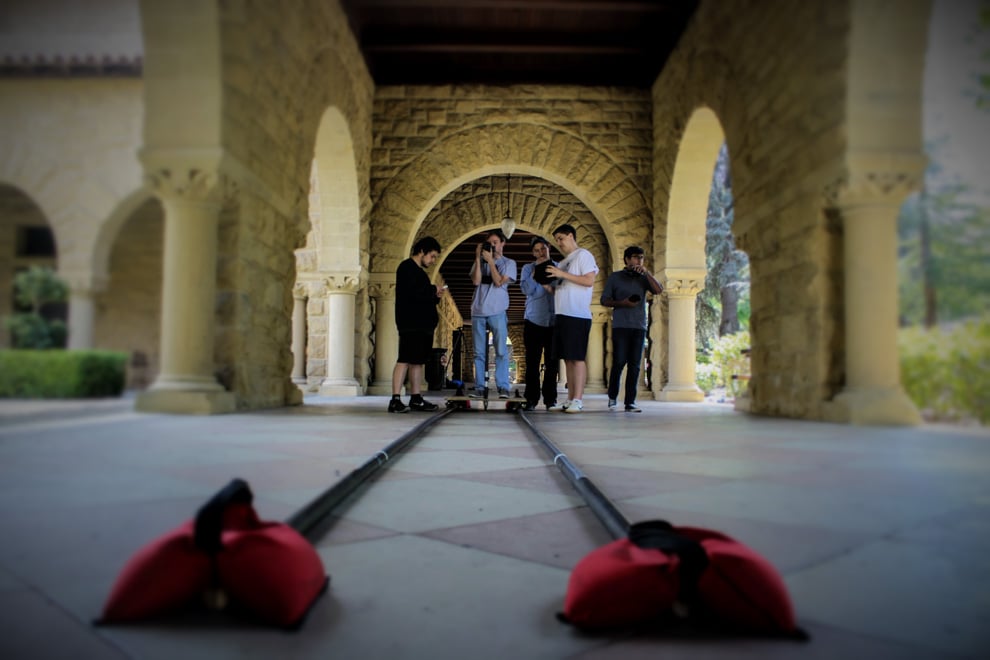You come to Stanford to play football. You come to Stanford to study computer science. You come to Stanford to be the next big thing in Silicon Valley.
You do not come to Stanford, however, to make films.
It’s an unfortunate truth, though one that has always been reflected in the construction of the University’s recently conceived Film and Media Studies program.
Launched back in 2005 by Kristine Samuelson, then-director of Stanford’s renowned graduate department for documentary filmmaking, the goal of Stanford’s Film and Media Studies program is not, nor was it ever, to provide students with a complete education in film and video production.
“This won’t be USC North,” said Samuelson in a 2005 Art History newsletter describing her original vision for the university’s first curriculum for the study of film. “In addition to fundamentals in film and video production, our majors will delve into cinema history, narrative analysis and screenwriting, film criticism and aesthetics, and film and media theory.”

The newsletter also described the University’s desire to oversee the development of an MFA program, which would be launched in autumn of 2006, the following year. This program, which would be grounded in production and would provide undergraduate students with the chance to engage with graduate-level fiction filmmakers, never came to fruition.
Jumping to the present day, Stanford’s film and media studies program is currently fully operational. With a staff that includes Professor Scott Bukatman, Associate Professors Jean Ma and Pavle Levi, Senior Lecturer Adam Tobin, and Lecturers Laura Green and J. Christian Jensen, Stanford’s young film program has just begun to find its feet. Yet, despite the program’s successful inception, the department continually struggles to meet student demand for production-based coursework.
Though Samuelson may have imagined a program that would teach students the “fundamentals of film and video production” there are currently only two courses offered at Stanford that teach production in any sense of the word. Moreover, one of these two courses, “Image and Sound: Filmmaking for the Digital Age” is largely intended for underclassmen to fulfill their creative expression requirement, and is not necessarily for already declared film majors.
With that being said, it should be noted that Stanford is not completely devoid of classes based in the practice of filmmaking technique. Each year, Senior Lecturer Adam Tobin offers a number of courses in the art of screenwriting designed to educate students on the basics of narrative analysis and narrative construction. These courses are incredibly popular among non-film and film majors alike.
Yet, for many, excellent instruction in screenwriting is simply not sufficient to satisfy a desire to develop a broad and diverse skill set.
“I wish that there were more filming opportunities here at Stanford,” said Tess Picknell ’16, a current Film and Media Studies major. “Specifically, introductory filming opportunities.”
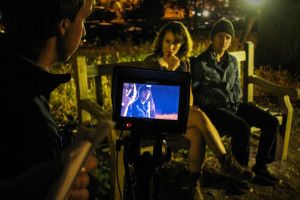
Consequently, most students interested in film and video production have had to look outside the classroom for on-set experience. In turn, a handful of student-run organizations have mobilized to meet the need, most prominent among them, the Stanford Film Society.
Founded back in 1994, the film society has proven a tried-and-true supplement to Stanford’s nearly non-existent production opportunities. As their mission statement describes, “the purpose of our society is to give students the opportunity to approach all aspects of film and filmmaking in a serious, meaningful, and in-depth manner.” Overseeing everything from guest speakers to film screenings, the film society endeavors to remedy the problems many filmmakers face at Stanford.
Current co-president Laurel Pecchia ’16 sees the future of SFS defined by this drive to make student filmmaking a reality. “We want to make equipment more accessible and to make students more aware that the equipment is accessible.”
Film and Media Studies peer advisor Toamatapu Lohe ’16, however, worries that SFS is still not doing enough to encourage student production on campus.
“In the past, the years that I’ve been here, it’s mainly been inactive,” Lohe said. “There was equipment for people to make their own stuff, but the thing is that students need to be prompted with some kind of organization.”
Enter Cardinal Studios, an unofficial coalition of student filmmakers realized with the assistance of the Advanced Filmmaking Workshop (also known as the Cardinal Filmmaking Workshop) — a subdivision of SFS, the goal of which is “teach and collaborate,” and, as the website states in bold, “MAKE films.” Just now beginning to crystalize as the quarter comes to a close, Cardinal Studios is the brainchild of AFW president Will Hamilton ’15 and Lohe, also the equipment manager for SFS. The ragtag group, in purgatory for nearly a year, once intended to offer quarterly grants, but has since elected to “support student film production on campus,” working to complement the opportunities and resources of SFS.
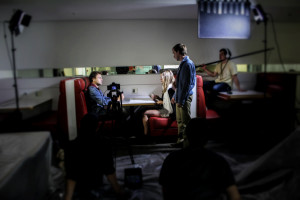
“I came in and I talked to Will and we had the idea: Why don’t we use the advanced film workshop to support a student film production company,” Lohe said.
Thus, armed with the equipment already available to students through SFS — including cameras, tripods and professional lighting and sound equipment — Lohe and company reached out to sophomore Raquel Shrestha ’17 to take part in the search for a script to develop into Cardinal Studio’s first official student film. In early January, the group launched a campus-wide competition before settling on a victor, a little film called “A Gate Between.” Unfortunately, the script for “A Gate Between,” would soon prove problematic.
Written by junior Alex Dunlap ’16, the screenplay for “A Gate Between” was eventually placed on the back burner, a decision that derived from a series of rather insurmountable production difficulties. Due to the inclusion of child actors and animals — both of which are notorious in the film business for wreaking havoc on unprepared productions — the fledgling Cardinal Studios elected to delay their work on “A Gate Between,” hoping to make the story into Cardinal Studios’ second or third original film.
In need of a replacement, the search began anew. Ultimately, another script, already under extensive consideration, was found victorious: Alexander Kucy’s ’17 “Prisoner,” a heavily allegorical narrative about the precarious relationship between a prisoner and his guard. Taking place entirely within the confines of a lone holding cell, the script was the perfect fit for a production company just trying to get off the ground. One location, two actors: It was a simple solution to a complex problem.
With the most strenuous decision out of the way, the executive board, then composed of producers Kucy, Lohe, Shrestha and Hamilton, began pursuing cast and crewmembers to make “Prisoner” a reality. Freshman Becky Aydin ’18, a New York City native with an impressive background in film production, was selected to direct the film, while freshman Carlos Valladares ’18 and junior Daniel Johnson ’16 were cast in the lead roles. Tapping into Stanford’s film community, various students were then selected to fill out the remaining on-set positions.
Weeks later, after extensive rehearsals — “We knew there would be a lot of technical stuff to worry about on set,” says Kucy — the film was ready to shoot.
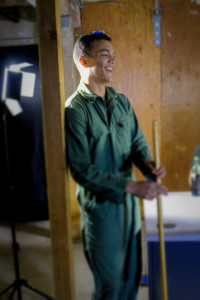
Although not without difficulties — Shrestha was forced to step in as director of photography when the original DP quit the production, issues with location arrangements led to a drastically reduced shooting schedule — the production of “Prisoner” went fairly smoothly, and, after talking to the cast and crew, it would appear that most parties involved would call the film a success.
Valladares said of the shoot, which occurred over the course of a singular weekend: “For me it was pretty pleasant experience… It was really fun getting to help build these characters and get to know them and their inner psychologies… It’s definitely made me want to pursue more technical aspects of film, like pursuing writing, or perhaps directing.”
Before a press screening of the final cut, Kucy echoed Valladares’s sentiment: “It makes me really hungry to do another film because we did a lot of stuff right” but “there were a lot of growing pains.”
After catching a sneak-peek of the finished film, I can attest: “Prisoner” is not without its faults. But for Kucy, the quality of the finished product is irrelevant.
“The first day of rehearsal Carlos [started] with his opening monologue, [and] I just got like such shivers to hear my stuff being spoken.”
For Kucy, “Prisoner” is just the first step on a much larger journey, a journey that will allow others, like Kucy to see their artistic aspirations rendered concrete.
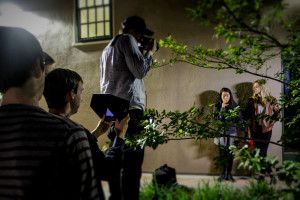
In fact, with “Prisoner” only recently completed, Cardinal Studios is already hard at work on their second short. Entitled “The Claw,” writer/directors Connor Huchton ’16 and Ed Heffernan ’15 describe Cardinal Studios’ latest as a cross between Rian Johnson’s “Brick,” Tony Gilroy’s “Michael Clayton” and David Fincher’s “The Social Network.” A sort of new-age film noir, “The Claw” was shot in the early weeks of spring quarter, and Lohe is already eyeing a June 3 release.
Like a cinematic Ram’s Head Theatrical Society, Cardinal Studios hopes to stick to this rapid turnaround time, cranking out at least one film a quarter.
You see, Lohe, like Kucy, dreams that Cardinal Studios will one day help to usher in a new age of film production at Stanford.
Referencing the innumerable computer science and engineering buildings on campus, Lohe argues, “all of those buildings that were built, they were built by donors. Once students start making actual successful films and they graduate and they become successful filmmakers and they come back to Stanford, then you will see an even greater change to people saying, ‘Oh, Stanford should become a premiere film school.” For Lohe, Cardinal Studios “is just the beginning.”
Though not an officially recognized student organization, Cardinal Studios aims to incorporate themselves into the existing infrastructure of the Stanford Film Society in the near future. In turn, Cardinal Studios’ leadership hopes the ambitious group will help to change the way the university engages with on-campus film production.
Contact Will Ferrer at wferrer ‘at’ stanford.edu
